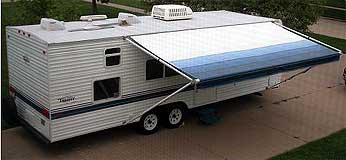Installing awnings on your RV can reduce interior temperatures by many degrees, decrease the heat load on air conditioners, block out the sun’s UV (ultra-violet) rays that can damage interiors, let you leave windows open during light rain and even give you a extra “room” to make outdoor living more pleasurable. Therefore, although relatively expensive, awnings are a good investment if you care for them so they last long enough for the investment to pay off.

Two types of awning materials are typically used - vinyl or acrylic - each with advantages and disadvantages. Vinyl awnings do not leak and are usually two-to-three hundred dollars less expensive for large canopies. Acrylic leaks, really it “breathes,” so moisture passes through and so does air, making them noticeably cooler underneath. Given proper care, both will last equally as long, though vinyl requires a bit more care. Tears in vinyl awnings are more easily repaired with commercial products like PlastiSeam.
Awnings should be cleaned at least every couple months during the seasons when the RV is regularly used, and more often in dusty and dirty environments. Use a cleaner specifically formulated for cleaning vinyl or acrylic material, not ordinary household cleaning products. A combination brush and nozzle connected to a garden hose, the type used to wash cars, is great for scrubbing off embedded dirt. You can often remove tree pitch from awnings by freezing it with ice cubes. This should allow the pitch to be broken off. However, tree sap is virtually impossible to remove. The best solution is to not park underneath trees.
Use a stepladder when cleaning or treating large canopies. Pull out the fully retracted awning in three foot segments, thoroughly cleaning each segment before pulling out the next three feet. Repeat the process to clean the underside. Then let the awning dry completely before rolling it up again. If you have to roll up a wet awning in a rainstorm, unroll the awning and let it dry out at the first opportunity. When taking an RV out of long term storage, unroll, then wash and treat the canopy, then let it dry out. If you store your RV outdoors, it might be a good idea to unroll and air out the awning a couple of times during the off season, on nice days.
Wind is an awning's greatest enemy. While awnings can easily handle a mild breeze, they cannot withstand strong winds, even those that are far short of gales and hurricanes. Unless, you can be absolutely sure that even a moderate wind will not come up, roll up awnings when you leave your RV for any significant period. Also it is a good idea roll up awnings at night. There are few things more unpleasant than waking up to the sound of a flapping awning in the middle of then night. Unless it is having to go outside and roll it up with the wind howling, or worse, in pouring rain. In cases of a serious storm, it may be too late to save the awning.
If you have a new awning, practice rolling it up until you can do it practically blindfolded. Use tie-down straps and anchors to secure awnings the to the ground. Tie-downs are especially critical if you plan to leave an unrolled awning unattended. They should be attached completely vertical rather than at angles. Awning clamps can eliminate annoying awning flutter and flapping.
While strong winds can do expensive damage to both an awning and the RV to which it is attached while an RV is parked, strong winds can be downright dangerous while driving if they cause an awning to unfurl. Besides startling the driver possibly causing an accident, a large unrolled awning acts like a sail that can provide sufficient force so that you might lose control of your RV. As soon as you start feeling substantial winds while driving and especially if you hear strange noises coming from the awning, pull over and check all your awnings to ensure they are properly secured, and then drive slower. If winds are particularly strong, stop and park your rig and wait until the wind subsides.
Finally, since awnings are expensive, make sure your RV insurance covers wind and other damage to them.




